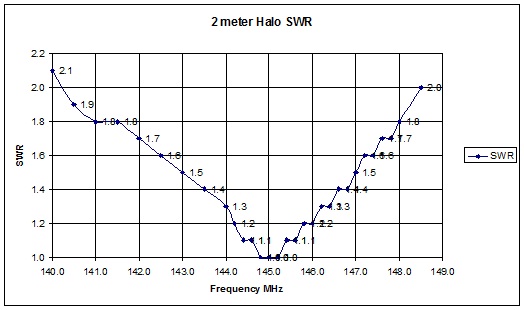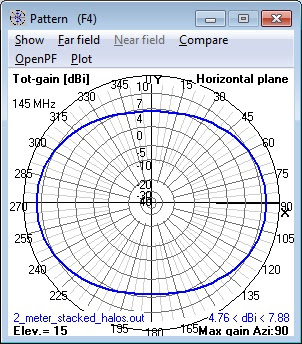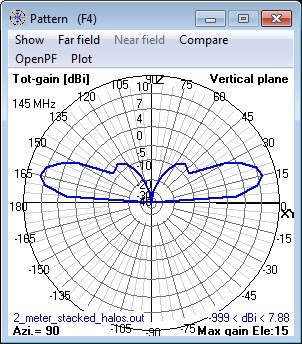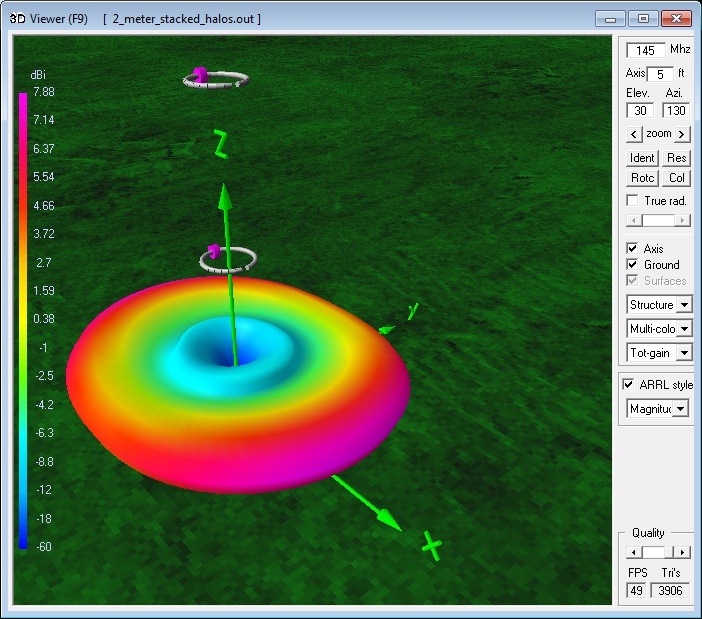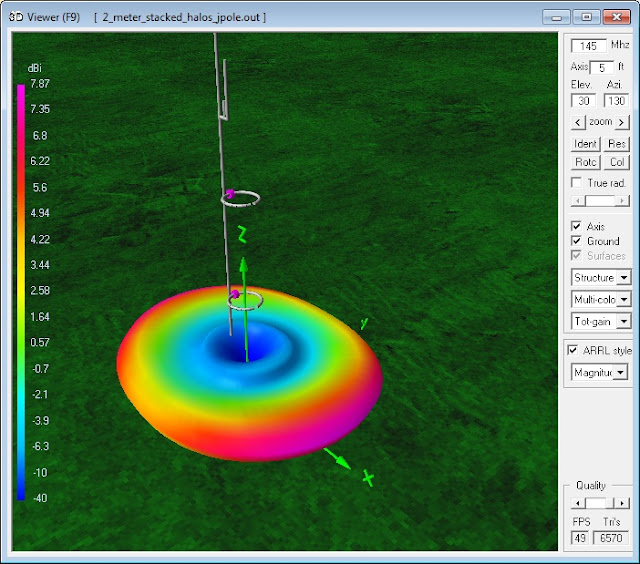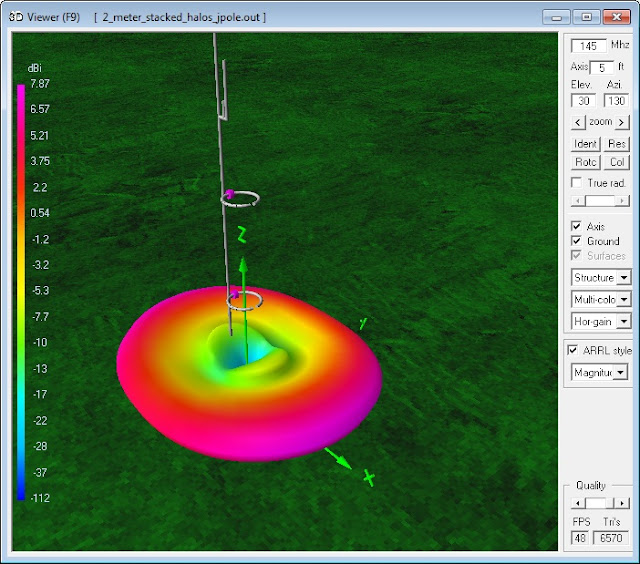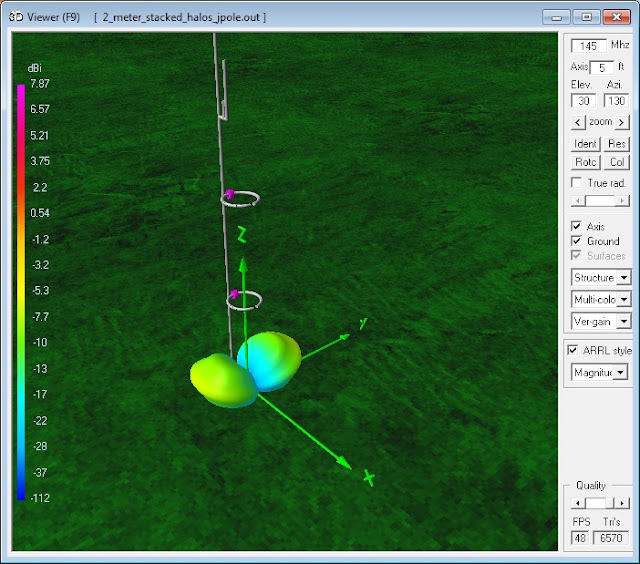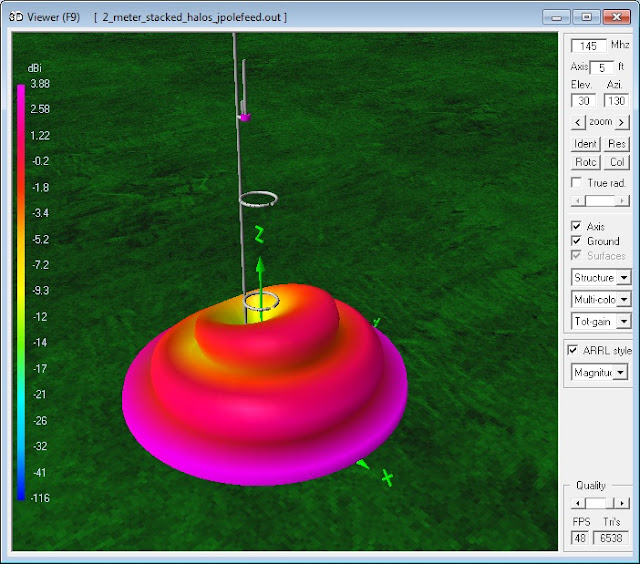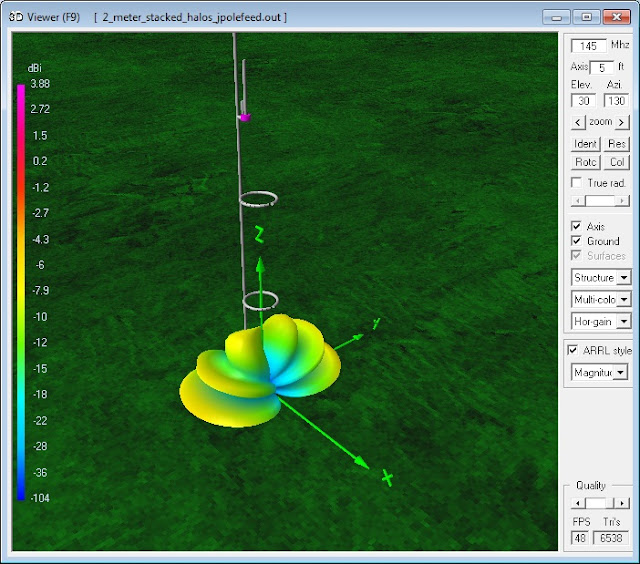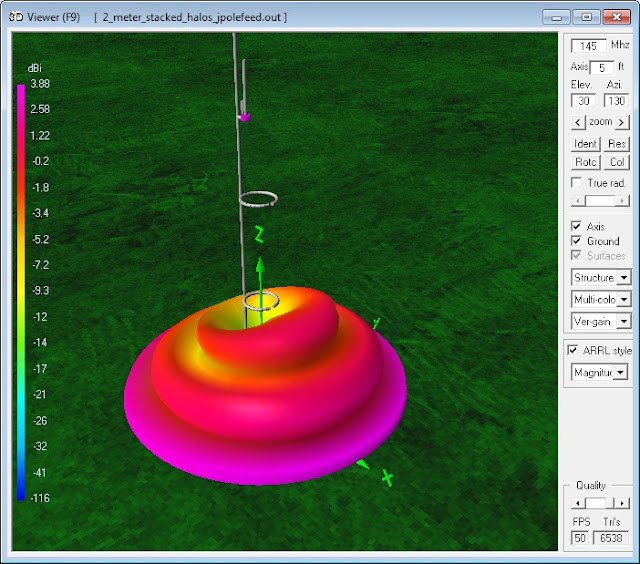144 MHz Halo Antenna
|
||
|---|---|---|
|
|
||
|
1. Here is one of the pair of 2 meter Halo antennas I built this week. I needed a horizontally polarized antenna for a 144 MHz WSPR propagation study and planned to stack these to increase omnidirectional gain. I will use it with my Elecraft XV144 transverter and amplifier with 100 watts peak output power and lower loss RG-8/U coaxial cable feed line. The materials for this one antenna cost about $6. Commercial versions cost about $50 or more. |
2. The boom is an 18 inch (46cm) piece of the 1/2" (12mm) Carlon "Plus 40" Rigid PVC Conduit that my husband had in the garden shed. I bought the 10 foot roll of 1/4 inch (6mm) copper tubing for $9 at Home Depot. It comes coiled in nearly the required diameter. I cut a 41 inch (104cm) length of it and easily formed it into the 13-1/8 inch (33.3cm) diameter shape. The loop is continuous except for a gap between the open ends at the right end of the boom. |
3. The resonant frequency of the antenna will vary with the distance between these open ends. After adjustment, UV resistant cable ties and a piece of 1/4 inch (6mm) fiberglass rod on the open ends of the halo antenna secure the gap spacing. The open ends of the boom will later be weatherproofed with self-sealing silicone tape. |
|
5. The 6-32 x 1" screw is soldered to the center pin of the SO-239 connector. |
6. The PVC Boom is drilled for the SO-239 antenna connector. The center pin is 1-7/8" away from the center point of the copper tubing. |
|
|
7. Several #6 washers were placed under a #6 nut to securely maintain its position and to prevent traction on the solder joint when the mica trimmer capacitor is secured onto the screw. |
8. The SO-239 antenna connector is secured to the PVC boom with two 6-32 x 1.5" screws. |
9. The shell of the SO-239 connector is connected to the copper tubing with 12 AWG bare copper wire which is soldered to the tubing. |
|
10. The side of the boom behind the SO-239 antenna connector. The tab on one side of the Arco 462 10-80 pF mica compression trimmer capacitor is bent up to be in line with the body of the trimmer and secured with a 6-32 nut onto the 6-32 screw that is soldered to the center pin of the SO-239 connector. The 7 inch gamma arm will be soldered to the other tab. |
11. Close-up view of the mica compression trimmer capacitor connected between the gamma match rod and the screw on the center pin of the SO-239 antenna connector. |
12. I investigated several feed methods and selected a gamma match with a 10-80 pF mica compression trimmer capacitor (Arco 462 type) soldered to a 6 inch length of the 1/4 in. tubing. At maximum capacitance, it barely brought the impedance 50 ohms and zero reactance. The back-to-back alligator clips are a temporary shorting bar. |
|
Tuning the antenna requires three adjustments: the gap space, the shorting bar location and the capacitor, and these all interact.
|
||
|
13. The original 1/4 in. tubing gamma match arm was replaced with a 7" length of 10 AWG bare copper wire spaced 1-7/8" from the radiator element. This decreased the capacitance required to achieve the non-reactive 50 ohms impedance match. |
14. 20 May 2012 - The 144 MHz halo antenna was mounted at 80 inches (1 λ) above the metal roof and fed with Belden 8214 foam type RG-8/U coaxial cable. At first, the antenna resonance was unstable and sensitive to the routing of the feed line until 5 turns of it were wound to form a 8 inch diameter choke balun. The standing wave ratio was then measured as 1:1 at 145.0 MHz. |
15. A closer view of the 144 MHz halo antenna. The entire antenna was weatherproofed with clear acrylic spray paint. The open ends of the boom and the PL-259 connector were sealed with a self sealing silicone tape called Rescue Tape. Both open ends of the copper loop were outside the boom with approximately 1.5 inch gap distance for resonance at 145 MHz. |
|
16. Close up view of the PL-259 antenna connector sealed with Rescue Tape. The open spaces between the boom and the SO-239 connector were sealed with GOOP Plumbing contact adhesive and sealant, selected as it does not release corrosive acetic acid during curing. |
17. 144 MHz Halo antenna NEC model calculated SWR vs. Frequency. |
18. 144 MHz Halo antenna measured SWR vs. Frequency. The SWR measured at the feed point was 1.3:1 or less over the 144.0 to 146.4 MHz range. |
|
19. 144 MHz Single Halo Antenna 4nec2 Calculations. As the gamma match is not amenable to accurate NEC modeling1, I used the high-pass L-network under the RLC matching function (F10) of 4nec2 when generating the frequency sweep curves in Figures 17 and 20. |
20. 144 MHz Halo antenna NEC Model calculated Resistance and Reactance vs. Frequency. |
21. 144 MHz Stacked Halo
antennas Resistance and Reactance vs. Frequency measured
with a miniVNA Pro vector network analyzer. |
|
22. 144 MHz single Halo Antenna azimuth pattern calculated by NEC Model. |
23. 144 MHz single Halo Antenna elevation pattern calculated by NEC Model. |
24. 144 MHz single Halo antenna 3 dimensional radiation pattern calculated by NEC Model. |
|
25. 144 MHz 2 stacked Halo Antennas azimuth pattern calculated by NEC Model. |
26. 144 MHz 2 stacked Halo Antennas elevation pattern calculated by NEC Model. |
27. 144 MHz 2 stacked Halo Antennas 3 dimensional radiation pattern calculated by NEC Model. |
|
28. 144 MHz 2 stacked Halo Antennas 4nec2 Calculations. |
CM 144 MHz Halo Antenna NEC model by Carol
F. Milazzo, KP4MD 29. 144 MHz Single Halo Antenna NEC model. |
CM 144 MHz 2 Stacked Halo Antennas at 40
and 80 inches NEC model by Carol F. Milazzo, KP4MD 30. 144 MHz 2 stacked Halo Antennas NEC model. |
|
31. Two identical 0.75 λ lengths of RG-11/U 75 ohm coaxial cable were prepared for the stacking harness. After trimming to achieve zero ohms reactance at 145 MHz, each of my cables measured exactly 40.25 inches from tip to tip. This measurement may vary slightly due to variations in the velocity factors among different batches and manufacturers of cable. |
32. The two lengths of RG-11/U cable are joined with a UHF Tee connector to form the stacking harness. When measured from either end of the assembled stacking harness, the SWR analyzer should indicate zero ohms reactance and over 300 ohms resistance at 145 MHz. When erected, the free end of each RG-11/U cable will be connected to a halo antenna and the 50 ohm feed line connected to the center of the Tee connector. |
33. The lower halo is mounted at 40 inches height (0.5 λ) above the roof and the upper halo is mounted 40 inches above it (1 λ). The gamma match sections should be oriented on the same side of both halo antennas. All the connectors are wrapped with self-sealing silicone tape. |
|
34. Durable weather shields are made from weather resistant 2 inch black vinyl caps. Its purpose is to protect the feed points and the gamma match capacitors from rain and the elements. |
35. A weather shield was secured over the feed point of each halo antenna. The spaces in and around the mating surfaces of all the connectors were filled with petroleum jelly, the connectors wrapped with self-sealing silicone tape, and open spaces sealed with silicone plumbing sealant. |
36. The blue line indicates the standing wave ratio for the stacked 2 meter halo
antennas is less than 1.4:1 over the 144 through 146 MHz frequency range, measured with a miniVNA Pro vector
network analyzer. |
NOTES ON HALO ANTENNA STACKING
|
37. Radio Mobile Online predicted line of sight signal strength for stacked halo antennas at KP4MD station in Citrus Heights, CA. Limit of WSPR reception at signal strength (0.004 µV) -30 dB to -20 dB SNR in orange area, greater than -20 dB SNR in yellow area. Transmitter power 50 watts, antenna height 6 meters. |
|
COMPARISON OF J-POLE VS. SINGLE AND STACKED HALO ANTENNAS
|
38. Video clips comparing
noise floor and received signals from KJ6KO/B on 144.283
MHz on Bald Mountain, CA. |
|
|
39. 144 MHz 2 stacked Halo
Antennas 3 dimensional radiation pattern calculated by
NEC Model. Composite of horizontal and vertical
polarization components. |
40. 144 MHz 2 stacked Halo
Antennas 3 dimensional radiation pattern calculated by
NEC Model. Horizontal polarization component only. |
41. 144 MHz 2 stacked Halo Antennas 3 dimensional radiation pattern calculated by NEC Model. Vertical polarization component only. |
|
42. 144 MHz Arrow OSJ 146/440 J-Pole Antenna 3 dimensional radiation pattern calculated by NEC Model. Composite of horizontal and vertical polarization components. |
43. 144 MHz Arrow OSJ 146/440 J-Pole Antenna 3 dimensional radiation pattern calculated by NEC Model. Horizontal polarization component only. |
44. 144 MHz Arrow OSJ 146/440 J-Pole Antenna 3 dimensional radiation pattern calculated by NEC Model. Vertical polarization component only. |
REFERENCES
|
APPENDIX: NEC Model Files
LINKS
|
|


